Quick Look
Grade Level: 4 (3-5)
Time Required: 2 hours
30 minutes is required for teams to paint their cardboard boxes a day or two before the rest of the activity. The activity can be split into two 60-minute sessions.
Expendable Cost/Group: US $2.00
Group Size: 4
Activity Dependency: None
Subject Areas: Data Analysis and Probability, Earth and Space, Measurement, Physical Science, Science and Technology
NGSS Performance Expectations:

| 3-5-ETS1-2 |
| 4-PS3-2 |
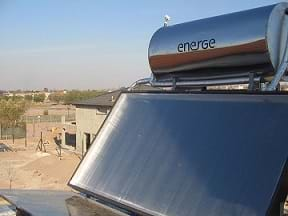
Summary
In the exploration of ways to use solar energy, students investigate the thermal energy storage capacities of different test materials to determine which to use in passive solar building design.Engineering Connection
Passive solar heating systems are simple and efficient ways to heat structures. When designing houses, engineers carefully choose insulation so it does not act as a passive heating system during high temperature days and during the spring and summer months. Engineers must design the insulation to reflect the internally-produced heat (to prevent it from escaping from the house) on cool days, as well as choose roof material that reflects the sun's heat on hot days.
Learning Objectives
After this activity, students should be able to:
- Explain how passive solar heating works.
- Describe materials that are appropriate for use in passive solar heating.
- Explain how engineers design passive solar heating systems for buildings.
Educational Standards
Each TeachEngineering lesson or activity is correlated to one or more K-12 science,
technology, engineering or math (STEM) educational standards.
All 100,000+ K-12 STEM standards covered in TeachEngineering are collected, maintained and packaged by the Achievement Standards Network (ASN),
a project of D2L (www.achievementstandards.org).
In the ASN, standards are hierarchically structured: first by source; e.g., by state; within source by type; e.g., science or mathematics;
within type by subtype, then by grade, etc.
Each TeachEngineering lesson or activity is correlated to one or more K-12 science, technology, engineering or math (STEM) educational standards.
All 100,000+ K-12 STEM standards covered in TeachEngineering are collected, maintained and packaged by the Achievement Standards Network (ASN), a project of D2L (www.achievementstandards.org).
In the ASN, standards are hierarchically structured: first by source; e.g., by state; within source by type; e.g., science or mathematics; within type by subtype, then by grade, etc.
NGSS: Next Generation Science Standards - Science
| NGSS Performance Expectation | ||
|---|---|---|
|
3-5-ETS1-2. Generate and compare multiple possible solutions to a problem based on how well each is likely to meet the criteria and constraints of the problem. (Grades 3 - 5) Do you agree with this alignment? |
||
| Click to view other curriculum aligned to this Performance Expectation | ||
| This activity focuses on the following Three Dimensional Learning aspects of NGSS: | ||
| Science & Engineering Practices | Disciplinary Core Ideas | Crosscutting Concepts |
| Generate and compare multiple solutions to a problem based on how well they meet the criteria and constraints of the design problem. Alignment agreement: | Research on a problem should be carried out before beginning to design a solution. Testing a solution involves investigating how well it performs under a range of likely conditions. Alignment agreement: At whatever stage, communicating with peers about proposed solutions is an important part of the design process, and shared ideas can lead to improved designs.Alignment agreement: | Engineers improve existing technologies or develop new ones to increase their benefits, to decrease known risks, and to meet societal demands. Alignment agreement: |
| NGSS Performance Expectation | ||
|---|---|---|
|
4-PS3-2. Make observations to provide evidence that energy can be transferred from place to place by sound, light, heat, and electric currents. (Grade 4) Do you agree with this alignment? |
||
| Click to view other curriculum aligned to this Performance Expectation | ||
| This activity focuses on the following Three Dimensional Learning aspects of NGSS: | ||
| Science & Engineering Practices | Disciplinary Core Ideas | Crosscutting Concepts |
| Make observations to produce data to serve as the basis for evidence for an explanation of a phenomenon or test a design solution. Alignment agreement: | Energy can be moved from place to place by moving objects or through sound, light, or electric currents. Alignment agreement: Energy is present whenever there are moving objects, sound, light, or heat. When objects collide, energy can be transferred from one object to another, thereby changing their motion. In such collisions, some energy is typically also transferred to the surrounding air; as a result, the air gets heated and sound is produced.Alignment agreement: Light also transfers energy from place to place.Alignment agreement: Energy can also be transferred from place to place by electric currents, which can then be used locally to produce motion, sound, heat, or light. The currents may have been produced to begin with by transforming the energy of motion into electrical energy.Alignment agreement: | Energy can be transferred in various ways and between objects. Alignment agreement: |
International Technology and Engineering Educators Association - Technology
-
Energy comes in different forms.
(Grades
3 -
5)
More Details
Do you agree with this alignment?
-
Models are used to communicate and test design ideas and processes.
(Grades
3 -
5)
More Details
Do you agree with this alignment?
State Standards
Colorado - Math
-
Represent and interpret data.
(Grade
5)
More Details
Do you agree with this alignment?
-
Display numerical data in plots on a number line, including dot plots, histograms, and box plots.
(Grade
6)
More Details
Do you agree with this alignment?
Colorado - Science
-
Identify and describe the variety of energy sources
(Grade
4)
More Details
Do you agree with this alignment?
-
Use data collection tools and measuring devices to gather, organize, and analyze data such as temperature, air pressure, wind, and humidity in relation to daily weather conditions
(Grade
5)
More Details
Do you agree with this alignment?
Materials List
Each group needs:
- cardboard box (large enough to accommodate four cans with thermometers; ask students to bring from home)
- 4 small metal cans (all about the same size; ask students to bring from home)
- 4 non-mercury thermometers
- paintbrush
- 1 cup (~250 ml) sand
- 1 cup (~250 ml) salt
- 1 cup (~250 ml) water
- 1 cup (~250 ml) shredded newspaper
- Capturing the Sun's Warmth Worksheet, one per group
For the entire class to share:
- black paint
- newspaper (to put under the boxes while painting)
- masking tape
- marking pens
- measuring cups (or jars with 1 cup [~250 ml] level marked; ask students to bring jars from home)
- 1-2 extra non-mercury thermometers
- chopsticks or plastic utensils for stirring
- sunglasses and other appropriate sun protection
- several potholders or gloves
Reuse/recycling/disposal note: Recycle the cans and shredded paper. Collect and reuse the salt and sand. Throw away newspaper with paint on it.
Worksheets and Attachments
Visit [www.teachengineering.org/activities/view/cub_energy2_lesson09_activity1] to print or download.Introduction/Motivation
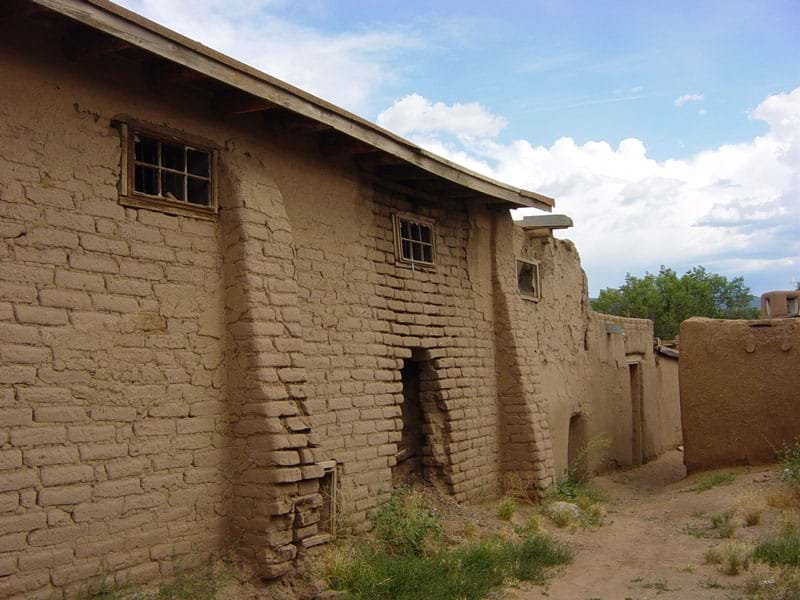
Have you ever wondered how your house stays warm in the winter and cool in the summer? Have you ever noticed that sometimes when it is cold outside, it is nice and warm in a sunny spot next to a window inside? Well, the sun is full of energy. We can use the sun's energy (solar energy) to help us heat our homes. 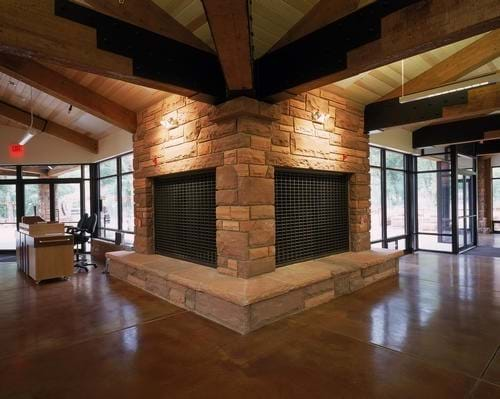
There are two ways civil engineers use solar energy to keep comfortable building temperatures: active solar heating and passive solar heating. Active solar heating systems use mechanical and electrical components to control the movement of warmed air or water. Passive solar systems use only the structure (floors, walls, windows) to collect, store and distribute heat from the sun in the winter and keep heat from the sun out in the summer. Passive solar heating systems can also be used to provide daylighting (natural lighting from the sun) to light up the inside of your house. People from different cultures and regions throughout history have used various types of passive solar design. Active solar systems require a lot more design, installation and maintenance than passive systems.
Engineers also think carefully about the type of materials used in building design. Some materials are good for thermal mass, or solar heat storage (see Figures 1 and 2), and some materials make good insulators to keep heat ( thermal energy) from leaving or entering the building. Materials that are slow to heat up and cool down provide thermal mass because they store more energy as temperature increases. Insulation stops heat from passing through. Insulating materials are important to include in passive solar design because they slow the amount of heat transfer in and out of buildings through the walls, floors and roof.
In this activity, we are going to be civil engineers and investigate the thermal energy storage capacities of four different potential thermal mass materials: sand, salt, water and shredded paper. We will evaluate the usefulness of each as a thermal storage material in a passive solar building.
Procedure
Teacher Background Information on Passive Solar Design
There are three necessary elements in passive solar design: a collector, thermal mass and some sort of control system. Thermal mass is a body of material with a significant density, such as a concrete floor, brick wall or barrel of water. Sunlight strikes the thermal mass after entering through the collector — a window. The efficiency of a passive solar system is greater if the thermal mass has a dark surface so it absorbs more sunlight. A simple control system might be a window overhang or awning, blinds or curtains.
In direct gain systems, sunlight enters through a window and directly strikes the building's thermal mass. A direct gain system with a winter sun angle is shown in Figure 3.The solar energy is absorbed by a masonry floor and/or interior walls in the building, thus increasing their temperature, which stores the energy. At night, the energy stored in the thermal mass is released because of the temperature difference between the thermal mass and the surroundings, warming the building interior. If ventilation and overhangs or other shading devices are used, this thermal mass can cool the building in summer. Ventilating a building at night exposes the thermal mass to cooler air and the thermal mass loses energy to the air. This cools the thermal mass. During the day, the thermal mass absorbs energy from the surroundings, cooling the building.
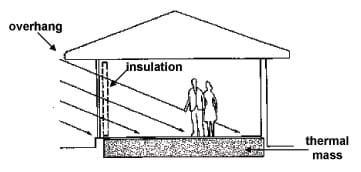
In indirect gain systems, such as the Trombe wall shown in Figure 4 below, sunlight strikes a dark wall that is placed between sun-facing (south in the northern hemisphere) windows and the building interior. The wall absorbs solar energy through radiation, stores it, and then releases it into the building when the indoor temperature falls below that of the wall's surface. These systems cannot be used for cooling. Trombe walls must be shaded in summer to avoid overheating the building.
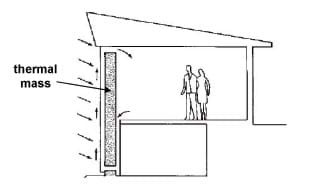
In insulated gain systems (sunspaces), a separate room with a thermal mass floor or inside walls is designed to store thermal energy. Heat is distributed throughout the building through ceiling vents, floor vents, windows and doors. Sunspaces cannot be used in summer for cooling, except for improving ventilation. It is best to minimize or eliminate ceiling glazing in sunspaces because it causes overheating in summer.
For an in-depth discussion of thermal energy, heat transfer, and why some materials can store thermal energy better than others, see Energy unit, Lesson 6: How Hot Is It? and How Much Heat Will It Hold? activity.
Before the Activity
- A few days in advance, gather boxes, cans and jars from the students.
- Divide the class into teams of four students each.
- A day or two before the activity, set aside ~30 minutes for teams to paint the outside of their cardboard boxes black. Spread out newspaper to protect table tops. Use masking tape and markers to label the boxes with their names (or team names).
- If using jars to measure insulation materials, have students brainstorm how to modify a jar to measure specific volumes. (Answer: Pour a known volume of water into a jar and mark the line to which it fills.) For this activity, use tape or markers to indicate a 1 cup (~250 ml) level on each measuring jar.
- Gather remaining materials and make copies of the Capturing the Sun's Warmth Worksheet.
- Set up insulation material stations for sand, salt, water and shredded paper, each with measuring cups or jars.
With the Students
- Have each team use masking tape and markers to label their four cans: sand, salt, water, shredded paper.
- On their worksheets, have students predict which material they think will store solar thermal (heat) energy the best.
- Have each team member place 1 cup (~250 ml) of test material in its labeled can and place a thermometer in the center. When filling a can with sand or salt, pour in half of the material, add the thermometer, and then pour in the rest of the material.
- On their worksheets, have students record the initial temperature of each material.
- Place the cans inside the box and close the lid. If necessary, tape the lid closed.
- Move the cans and boxes outside to a sunny location.
- Use an extra thermometer to record the nearby outside air temperature, too, as a control.
- Leave the boxes for 30 minutes.
- Have one or two students take spare thermometers outside to measure and record the outside air temperature (as a control), and share the data with all teams.
- Have teams take turns opening their boxes. Have students record on their worksheets the temperature of the materials in each can. Then, close the boxes and leave them for another 30 minutes. Repeat this step one to three times. Use the back of the worksheet to record any data that does not fit in the data table.
- Put on potholders or gloves. Carefully stir the contents of each can occasionally and watch to see which temperature falls the slowest and which falls the fastest. Record this on the worksheet.
- Have teams complete the worksheet by graphing their results.
- Conclude with a class discussion to compare results. What can we conclude from our data? What do the graphs show us? Which material stores thermal energy from the sun best? Who predicted this correctly? How did the material temperatures compare to the outside air temperature at each measurement time? Which test materials lost heat the fastest? The slowest? See additional post-activity discussion questions / answers in the Assessment section.
Vocabulary/Definitions
active solar system: Solar systems that use electrical or mechanical components, such as fans, pumps and electrical controls in circulating fluids; these systems can be used for heating water or heating/cooling buildings.
daylighting: A passive lighting system that maximizes natural lighting from the sun for interior illumination.
insulation: A material used to prevent the passage of heat, electricity or sound; a non-conducting material.
passive solar system: Solar systems that do not require electrical or mechanical components. These systems directly heat water or buildings, or reduce solar heat gain (for example, with window awnings to keep buildings cool).
thermal energy: Heat energy produced when the molecules of a substance vibrate. The more heat a substance has, the more rapid the vibration of its molecules. Heat energy flows from places of higher temperature to places of lower temperature.
thermal mass: Material used to store thermal energy (heat). Stone, concrete, adobe, brick and water work best. Thermal mass is used in a building to absorb or emit heat, and reduce interior temperature swings.
trombe wall: A wall in a building that absorbs solar energy through radiation, stores it, and then releases it into the building when the indoor temperature falls below that of the wall's surface. Names after French inventor Felix Trombe in the late 1950s. See an example at NREL: http://www.nrel.gov/buildings/highperformance/zion_ee_features.html
ventilation: To admit fresh air into a space, to replace existing air.
Assessment
Pre-Activity Assessment
Prediction: Have the students predict which material they think will be the best thermal mass, or store the most solar energy. Record their predictions on the worksheets and the board.
Activity Embedded Assessment
Worksheet: Have students record measurements and follow along with the activity on their team worksheet. After students have finished their worksheet, have them compare answers with their peers. Review their worksheets to gauge their mastery of the subject.
Graphing: Have students create line graphs on their worksheets, showing how the temperature of each test material changed over time.
Post-Activity Assessment
Class Discussion: Discuss the following solar concepts with the students:
- What is passive solar design? (Answer: Passive solar design uses only the structure [floors, walls, windows] to collect, store and distribute heat from the sun in the winter and keep out heat from the sun in the summer.)
- Which of our test material(s) would be a good thermal mass (be the best at storing heat from the sun)? (Answer: Of the test materials, water or salt are the best. Even though sand is not a good thermal mass, it is better than paper, plastic or wood.)
- Which test material(s) would make good insulation (did not store the heat well)? (Answer: Shredded paper, because it traps a lot of air, which is a good thermal insulator.)
- Which test material(s) should an engineer/architect design into a passive solar home? (Answer: Water and shredded paper. Water because it would provide thermal mass. Shredded paper because it would provide insulation, another important characteristic of passive solar homes. Salt could be difficult to use because of its corrosive nature. If water was used, it would most likely be in a barrel or tank near the window. The water would store the solar energy and radiate it when the sun is gone.)
Design It: Have students act as engineers and draw a design for a passive solar home. Have them use the information they learned in this activity to choose insulation materials for the exterior walls and either a thermal mass floor or interior wall. Identify passive solar features and materials. Draw arrows showing how the sunlight would hit the house and where solar heat would result inside the house. (See Figure 3 for an example drawing with a thermal mass floor.)
Troubleshooting Tips
For an accurate comparison, use approximately the same volume of material in each can.
The cans get quite hot after sitting in the sun for hours, so make sure students use gloves or potholders to handle them.
Activity Extensions
Have students place their boxes/cans in the sun at different times of the day or year. Do they notice a difference in solar energy storage at different times?
Have teams of students investigate passive and active solar heating systems for buildings, and prepare posters or presentations for other classes.
Have students investigate the following strategies for cooling a building: shading, passive downdraft towers, roof ponds, placement of trees and other vegetation, roof sprinklers, fountains in an inner courtyard, earth tubes, solar chimneys, night ventilation and earth-sheltered construction.
Activity Scaling
- For lower grades, it may be easier to have one class set up with students taking turns measuring the different temperatures of the test materials. Another option is to have each team measure one material and compare answers at the end. Create a class table showing how the temperature in the box and the temperature of each material changed over time.
- For upper grades, have students make a graph showing how the temperature in the box and the temperature of each material changed over time. Compile each team's temperature measurements for each test material. Have students find the average temperature value at each time step. For extra practice, make graphs using the averaged temperature values for each test material.
Subscribe
Get the inside scoop on all things TeachEngineering such as new site features, curriculum updates, video releases, and more by signing up for our newsletter!More Curriculum Like This

Students learn how the sun can be used for energy. They learn about passive solar heating, lighting and cooking, and active solar engineering technologies (such as photovoltaic arrays and concentrating mirrors) that generate electricity.

Students are introduced to passive solar design for buildings — an approach that uses the sun's energy and the surrounding climate to provide natural heating and cooling. They learn about some of the disadvantages of conventional heating and cooling and how engineers incorporate passive solar design...

Students design and build their own model houses, and test them for thermal gains and losses during a simulated day and night.

Students learn how engineers use solar energy to heat buildings by investigating the thermal storage properties of some common materials: sand, salt, water and shredded paper. Students then evaluate the usefulness of each material as a thermal storage material to be used as the thermal mass in a pas...
References
Reardon, Chris. Thermal Mass. Updated March 1, 2004. Passive Design, Technical Manual, Design for Lifestyle and the Future, Commonwealth of Australia. (Australia's guide to environmentally sustainable homes; excellent source of background information on thermal mass in passive solar design) http://www.climatechange.gov.au/en.aspx
Trombe Walls. High Performance Buildings Research, Center for Building & Thermal Systems, NREL, Office of Energy Efficiency and Renewable Energy, U.S. Department of Energy. www.nrel.gov/ Accessed November 9, 2005.
Copyright
© 2005 by Regents of the University of Colorado.Contributors
Xochitl Zamora-Thompson; Sabre Duren; Jeff Lyng; Malinda Schaefer Zarske; Denise CarlsonSupporting Program
Integrated Teaching and Learning Program, College of Engineering, University of Colorado BoulderAcknowledgements
The contents of this digital library curriculum were developed under a grant from the Fund for the Improvement of Postsecondary Education (FIPSE), U.S. Department of Education and National Science Foundation GK-12 grant no. 0338326. However, these contents do not necessarily represent the policies of the Department of Education or National Science Foundation, and you should not assume endorsement by the federal government.
Last modified: October 28, 2020










User Comments & Tips